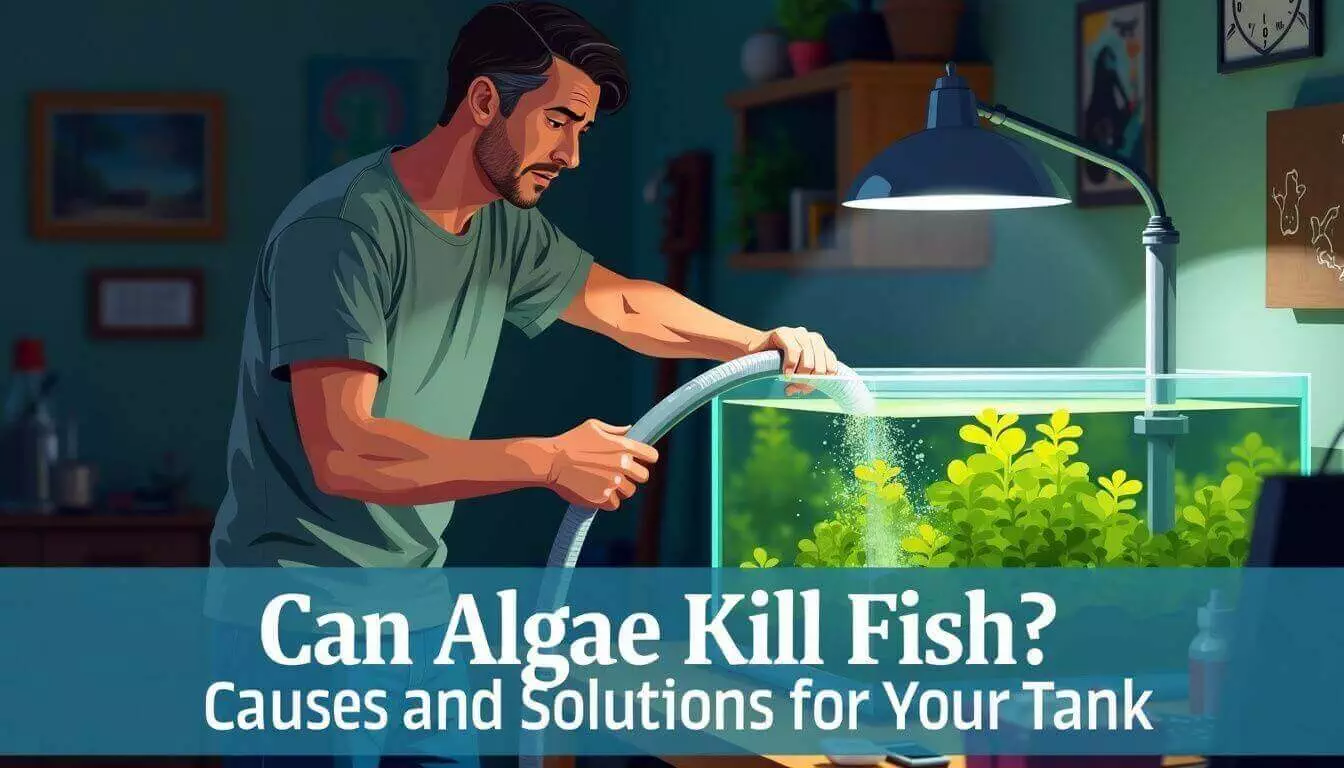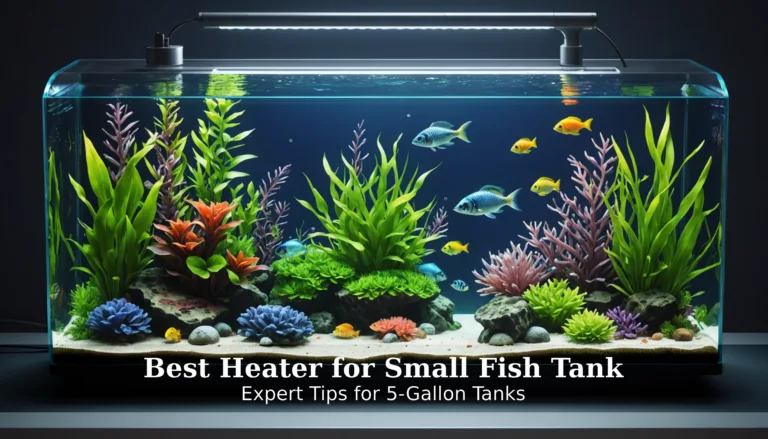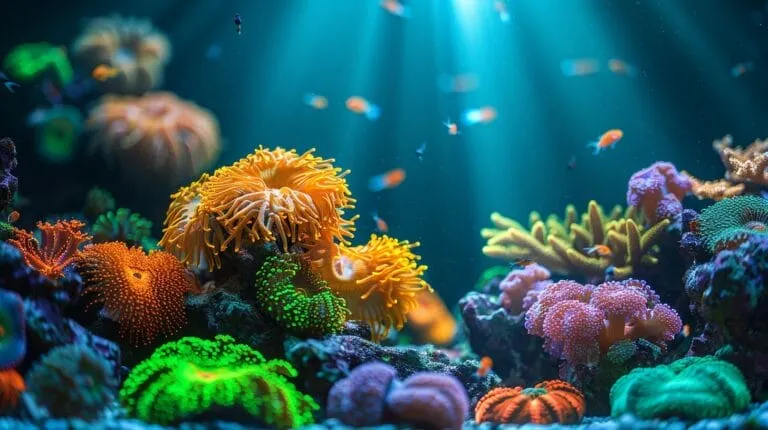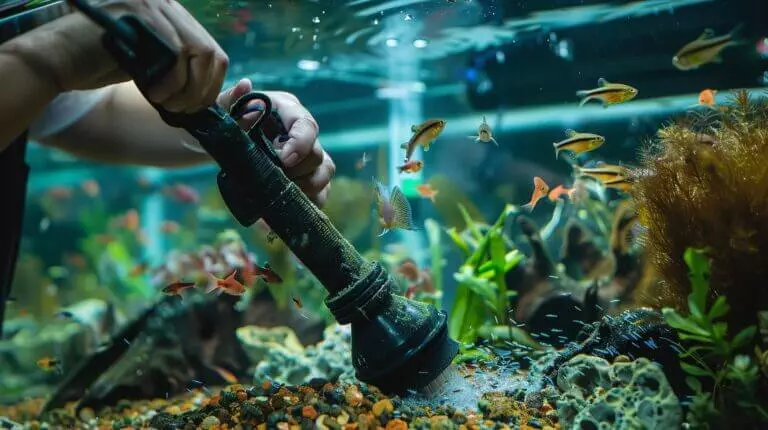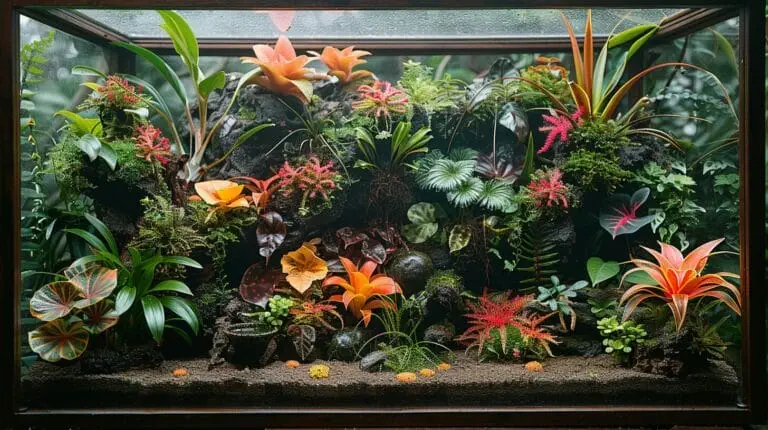Algae can kill fish. This surprising fact often shocks aquarium owners. Can algae kill fish? Yes, but not directly. Excess algae deplete oxygen in your tank, suffocating your fish. 3 As an aquarist with years of experience, I’ve seen the devastating effects of unchecked algae growth. Additionally, excessive algae can also create a toxic environment for fish by releasing harmful chemicals as they decompose. It’s important for aquarium owners to regularly monitor and control algae growth in order to maintain a healthy and balanced ecosystem for their fish. One common mistake is underestimating the potential impact of algae, especially in tanks with fish that have a goldfish size potential. These larger fish require even more oxygen and are particularly susceptible to the deadly effects of excessive algae. Minimizing health risks associated with aquariums should be a top priority for all fish owners. In addition to oxygen depletion and toxic chemical release, excessive algae can also lead to water quality issues and disease outbreaks in fish. Regular water changes, proper filtration, and maintaining a balanced ecosystem are essential for keeping algae growth under control and minimizing health risks associated with aquariums. By staying proactive and vigilant, fish owners can ensure a safe and healthy environment for their aquatic pets.
I’ve mastered the art of balancing aquatic ecosystems. My expertise comes from countless hours observing fish behavior and testing water parameters. This blog post will equip you with practical tips to manage algae and keep your fish thriving. 2 Ready to save your aquatic friends? 1
Key Takeaways
- Algae can kill fish by using up oxygen in the tank, especially at night.
- Harmful algal blooms (HABs) are very dangerous and can cause fish deaths.
- Regular water changes, proper lighting, and good filtration help prevent algae overgrowth.
- Some algae make toxins that can hurt or kill fish. Climate change is making this worse.
- Parasitic algae can attach to fish and cause harm. Treatments include medications, salt therapy, and UV sterilization.
Understanding the Oxygen Depletion Effects of Algae on Fish Health

Algae can suck up oxygen in your tank, leaving fish gasping for air. Too much algae growth can lead to low oxygen levels, which can harm or even kill your fish.
Recognizing the Signs of Hypoxia in Fish Populations
Fish in your tank may show signs of hypoxia if oxygen levels drop too low. Watch for fish gasping at the surface or hanging near air stones. You might see them move their gills rapidly or become less active.
Some fish may even lay on the bottom of the tank. These behaviors point to low oxygen in the water.
Hypoxia can result in mass fish kills. 1
Dead algae use up oxygen as they break down. This can cause oxygen levels to fall below 2 to 3 mg/L, which is dangerous for fish. 1 To avoid this, remove excess algae and dead plant matter from your tank regularly.
Good filtration and water movement also help keep oxygen levels up for your fish.
The Role of Algal Blooms in Reducing Dissolved Oxygen Levels
Algal blooms are like tiny plants that grow really fast in your aquarium. They can be a big problem because they use up all the oxygen in the water. Fish need oxygen to breathe, so when there’s not enough, they can get sick and even die.
This process leaves less oxygen for your fish and other aquatic life. During nighttime, algae stop producing oxygen but continue to use it up. This further reduces oxygen levels in your tank. 3
Harmful Algal Blooms (HABs) are the worst kind. They love warm water and places with lots of food. If you feed your fish too much or don’t clean their tank often, HABs can grow really fast. 2
Balancing Algae Presence to Maintain Optimal Oxygen Concentrations
Algal blooms can harm fish, but some algae are good for your tank. You need to find the right balance. Too much algae uses up oxygen that fish need. 3 Not enough algae means less food and shelter for fish.
Keep your tank’s algae in check with these tips: Control light exposure, remove extra nutrients, and add algae-eating fish. Test water often to catch problems early. A healthy tank has some algae, but not so much that it hurts your fish. Your goal is to create a stable environment where fish and algae coexist.
Removing Harmful Algae Varieties to Protect Aquatic Life

Algae can harm your fish if left unchecked. You need to know which types to remove and how to do it safely.
Identification of Algae Species That Pose a Risk to Fish
Some algae can harm your fish. You need to spot these bad guys fast. Blue-green algae, also called cyanobacteria, can make toxins. These toxins hurt fish gills and organs. Red tide algae, like Karenia brevis, can kill fish in saltwater tanks.
Golden algae blooms are super toxic to fish in fresh water. Look out for sudden changes in your tank. Green water or slimy growths on glass might mean trouble. Test your water often to catch problems early. 4 If you see dead fish, act quick. Remove the algae and change some water. Next, let’s talk about how to get rid of these nasty algae for good.
Effective Algae Removal Techniques for Aquariums and Ponds
Algae can be a real pain in your tank. Let’s look at some ways to get rid of it fast and keep your fish happy.
- UV Light Treatment: This is the best way to kill cellular algae. It’s safe for fish and works well. 5
- Manual Removal: Use algae scrubbers, Mag-Float glass cleaners, or toothbrushes to scrub off stubborn algae.
- Chemical Treatments: A 3% hydrogen peroxide solution can target tough algae. Be careful when using it.
- Liquid Algaecides: These work differently based on fish types and pond size. Use the right amount for your setup.
- Granular Algaecides: These are good for dry use. They’re safer for fish than liquid types.
- Water Changes: Regular water changes help remove excess nutrients that feed algae. 6
- Proper Lighting: Control light exposure to limit algae growth. Use timers for your tank lights.
- Nutrient Control: Don’t overfeed your fish. Extra food leads to more algae.
- Live Plants: Add live plants to your tank. They compete with algae for nutrients.
- Algae-Eating Fish: Some fish like plecos and otocinclus eat algae. They can help keep it under control.
Now that we’ve covered algae removal, let’s look at how to stop it from coming back.
Preventing Algae Overgrowth Through Regular Maintenance
Regular maintenance is key to prevent algae overgrowth in your tank. Here are some steps you can take to keep your aquarium clean and algae-free:
- Change water weekly: Do 10 to 20% water changes every week. This cuts down nutrients that feed algae. 7
- Control lighting: Keep lights on for only 8 to 10 hours a day. Too much light helps algae grow fast.
- Add live plants: Plants use up nutrients that algae need. This slows algae growth in your tank.
- Watch feeding: Don’t overfeed your fish. Extra food breaks down and feeds algae.
- Clean filters: Rinse your filter media in old tank water often. This keeps good bacteria and removes waste.
- Scrub surfaces: Use a soft brush to clean tank walls and decor. This stops algae from sticking.
- Test water: Check pH, ammonia, nitrite, and nitrate levels. Fix any issues fast to stop algae blooms.
- Use algae eaters: Add fish or snails that eat algae. They help keep your tank clean.
- Avoid sunlight: Keep your tank away from windows. Direct sun can cause algae to grow quickly.
- Remove dead matter: Take out any dead plants or fish right away. They rot and feed algae.
The Toxic Relationship Between Certain Algae and Aquatic Ecosystems

Some algae can make toxins that harm fish. These poisons can hurt or kill fish in your tank. Want to know more about this toxic threat? Keep reading!
Understanding Algal Toxins and Their Impact on Fish Health
Algal toxins pose a serious threat to your fish. These harmful substances come from certain types of algae in your tank. Microcystis and Karenia brevis are two common culprits. They produce toxins that can hurt or kill fish. 2 You might notice your fish gasping for air or swimming oddly. These are signs of toxin exposure.
Climate change is making this problem worse. Harmful algal blooms are happening more often. 8 They’re also getting stronger. This means more risk for your aquarium fish. To keep them safe, you need to watch for algae growth.
Clean your tank regularly. Test the water often. If you spot unusual algae, act fast to remove it. Your quick action can save your fish from these dangerous toxins.
Case Studies of Algal Toxicity Incidents in Natural and Artificial Habitats
Harmful algal blooms have caused major fish kills in both natural and man-made settings. In 2018, a massive bloom of Karenia brevis off Florida’s coast killed thousands of fish, turtles, and dolphins. The toxins produced by this algae paralyzed marine life and depleted oxygen in the water. 9
Your home aquarium can face similar risks on a smaller scale. A 2020 study found that dense growths of blue-green algae in fish tanks released toxins that killed over 75% of fish within 48 hours.
To keep your fish safe, it’s important to check the water quality often and get rid of any algae you see. Don’t feed your fish too much, use a good filter, and make sure the water temperature and other conditions are just right. This will help stop algae from growing too much and making your fish sick.
Measures to Detect and Mitigate Toxic Algae Presence
Toxic algae can harm your fish and ruin your tank. Here are key steps to spot and stop these harmful blooms:
- Test water often: Use test kits to check for high nutrient levels. These can fuel algae growth.
- Look for warning signs: Watch for green, slimy patches or odd smells in your tank.
- Monitor pH levels: Algae thrive in certain pH ranges. Keep yours stable.
- Control light exposure: Too much light feeds algae. Use timers on tank lights.
- Clean filters regularly: This removes excess nutrients that algae need to grow.
- Add live plants: They compete with algae for nutrients and help balance the tank.
- Use algae-eating fish: Species like plecos can help keep algae in check.
- Perform water changes: Regular changes remove toxins and excess nutrients.
- Avoid overfeeding: Leftover food decays and feeds algae. Feed small amounts.
- Use UV sterilizers: These devices kill algae spores in the water.
- Try chemical treatments: As a last resort, use algaecides made for aquariums.
- Quarantine new plants: This stops algae from entering your main tank.
Parasitic Algae: A Hidden Threat in Aquatic Environments

Parasitic algae lurk in your tank, ready to harm your fish. These tiny threats can attach to your fish, causing damage and stress.
The Lifecycle of Algae That Function As Parasites
Algal parasites have a sneaky life cycle. They attach to host algae and steal their nutrients. These tiny thieves grow inside their victims, forming spores. The spores burst out, killing the host.
Then they spread to infect more algae. This cycle repeats, wiping out large algal populations fast. 11
You can spot parasitic algae in your tank with a keen eye. Look for odd growths or discolored patches on your plants. Use a magnifying glass to see tiny spores. If you notice these signs, act quick.
Remove infected plants and do a partial water change. This stops the spread and keeps your tank healthy.
Treatment Options for Fish Affected by Parasitic Algae
Now that you understand the lifecycle of parasitic algae, let’s explore how to treat affected fish. Proper treatment is key to saving your aquatic pets from these harmful organisms. Here are effective options:
- ICH-X treatment: This medication targets external protozoan parasites. It’s safe for scaleless fish and plants, making it a go-to choice for many aquarists. 12
- ParaCleanse regimen: Use this for internal parasites. Give multiple doses as directed for best results. It also works on some external parasites.
- Aquarium salt therapy: Add salt to your tank to help with external parasites. Note that it’s less effective for internal issues.
- Copper-based medications: These work well against many parasites. Be careful, as copper can harm some fish and invertebrates.
- UV sterilization: Install a UV sterilizer to kill free-floating parasites in the water column. This helps prevent spread and reinfection. 13
- Quarantine measures: Isolate sick fish in a separate tank for treatment. This stops parasites from spreading to healthy fish.
- Raised water temperature: Some parasites can’t survive in warmer water. Slowly increase tank temperature as tolerated by your fish species.
- Frequent water changes: Remove 10 to 20% of tank water daily during treatment. This helps get rid of parasites and their eggs.
- Substrate vacuuming: Clean gravel thoroughly to remove parasite eggs and larvae that may be hiding there.
- Medication-infused food: For internal parasites, use medicated fish food. This ensures the treatment reaches the affected areas.
Long-Term Strategies to Prevent Parasitic Algae Infestations
After treating fish affected by parasitic algae, you’ll want to stop future problems. Long-term strategies can keep your tank healthy and algae-free. Here are key steps to prevent parasitic algae infestations:
- Clean regularly: Vacuum gravel weekly. Wipe tank walls monthly. Remove dead plants and uneaten food daily.
- Control light: Limit tank light to 8 to 10 hours per day. Use timers for consistency. Avoid direct sunlight on the tank.
- Balance nutrients: Test water weekly for nitrates and phosphates. Change 10 to 20% of water every 1 to 2 weeks. Don’t overfeed fish.
- Add live plants: Fast-growing plants like hornwort or anacharis compete with algae for nutrients.
- Use algae eaters: Add snails, shrimp, or fish like otocinclus to eat algae naturally.
- Install proper filtration: Use a filter rated for your tank size. Clean or replace filter media monthly.
- Maintain water flow: Use powerheads or air stones to increase oxygen and prevent stagnant areas. 14
- Quarantine new additions: Keep new fish or plants separate for 2 to 4 weeks before adding to main tank.
- Monitor water quality: Test pH, ammonia, and nitrite levels weekly. Keep parameters stable and in safe ranges.
- Avoid overfeeding: Feed fish only what they can eat in 2 to 3 minutes, once or twice daily.
How the Ecosystem Dynamics Relate to Algae and Fish Populations

Algae and fish form a delicate balance in your tank. This balance shapes the health of your whole aquatic world.
The Symbiotic Relationships That Can Exist Between Algae and Fish
Fish and algae often work together in your tank. Some fish eat algae, keeping it under control. This helps your tank stay clean. At the same time, algae make oxygen for fish to breathe.
In coral reefs, this teamwork is even more important. About 25% of sea life lives in these reefs, thanks to algae-fish partnerships. 15
Tiny algae and bacteria also team up in your aquarium. They make food easier for fish to use. Scientists are now looking at new ways algae and other tiny life forms can help each other.
This could lead to better ways to keep your fish healthy and your tank balanced. 16
Monitoring Ecosystem Health to Predict Algae-Related Risks
Algae and fish can live together in harmony, but balance is key. Keeping an eye on your tank’s health helps spot algae risks early. Remote sensing and machine learning now help detect harmful algal blooms (HABs).
These tools track changes in water color and temperature. They alert you to potential problems before they harm your fish. 9
Regular water tests are crucial for home aquariums. Check pH, ammonia, and nitrate levels often. High nutrients can fuel algae growth. Climate change and pollution make HABs more common.
By watching these factors, you can act fast to protect your fish. Clean water and proper feeding help keep algae in check. Your quick action can save fish lives and maintain a thriving tank ecosystem. 2
Implementing Sustainable Aquaculture Practices to Minimize Algae Risks
Healthy ecosystems need balance. Smart fish farming helps keep algae in check. Here are key ways to make aquaculture more eco-friendly:
- Use recirculating systems. These setups filter and reuse water, cutting down on waste that feeds algae. You’ll save water and keep your fish healthier. 17
- Try multi-species farming. Grow different sea life together, like fish, shellfish, and seaweed. Each species uses nutrients the others don’t want. This natural cleanup crew stops algae from taking over.
- Manage waste well. Don’t let fish poop and uneaten food build up. Remove solid waste often. Good filters help too. Clean tanks mean less food for algae.
- Feed fish the right amount. Overfeeding leads to more waste and algae growth. Give your fish just what they need to stay healthy.
- Pick the best spot. Put fish farms where water flows well. Good water movement helps stop algae from settling in one place.
- Test water often. Check for signs of too many nutrients. If levels start to rise, you can act fast before algae becomes a problem.
- Use natural algae eaters. Some fish and snails love to munch on algae. Add a few to your tank as a living cleanup crew.
Conclusion
Algae can harm fish in your tank. You must keep algae in check. Remove excess algae and maintain water quality. Add plants to compete with algae for nutrients. Regular cleaning and proper feeding prevent algae overgrowth.
Your fish will thrive in a balanced, algae-controlled environment.
FAQs
1. Can algae kill fish in my tank?
Yes, some algae can harm fish. Harmful algal blooms in tanks can make fish sick or die. But not all algae are bad – some help make oxygen for fish.
2. What types of algae are risky for fish?
Brown algae and red tide algae can be harmful. Karenia brevis and Heterosigma akashiwo are two bad kinds. They can make toxins that hurt fish gills and cause fish to die.
3. How do I know if algae are hurting my fish?
Look for signs like fish gasping at the surface, not eating, or acting weird. If fish die suddenly, it might be due to harmful algae. Test your water to be sure.
4. Can I use chemicals to get rid of bad algae?
Yes, but be careful. Some algae control products can also harm fish. It’s best to ask a professional for help. They can suggest safe ways to fix the problem without hurting your fish.
5. Are there natural ways to stop harmful algae?
Sure! Add more plants to your tank. They use up nutrients that algae need. Also, don’t overfeed your fish. Extra food can make algae grow fast. Keep your tank clean and change water often.
6. How can I prevent harmful algae in my fish tank?
Keep your tank clean. Use a good filter and change water regularly. Don’t put the tank in direct sun. Feed fish the right amount. Test water often to catch problems early. These steps help stop bad algae before they start.
References
- ^ https://www.epa.gov/ms-htf/hypoxia-101 (2024-01-26)
- ^ https://www.niehs.nih.gov/health/topics/agents/algal-blooms
- ^ https://www.epa.gov/nutrientpollution/effects-dead-zones-and-harmful-algal-blooms
- ^ https://www.ncbi.nlm.nih.gov/pmc/articles/PMC9147682/
- ^ https://lakemanagementinc.net/get-rid-of-algae-in-your-aquarium/
- ^ https://www.tfhmagazine.com/articles/freshwater/algae-part-2-getting-rid-of-the-stuff-the-skeptical-fishkeeper
- ^ https://www.thesprucepets.com/aquarium-algae-1379979 (2024-07-25)
- ^ https://www.betterhealth.vic.gov.au/health/healthyliving/Harmful-algal-blooms
- ^ https://www.ncbi.nlm.nih.gov/pmc/articles/PMC10871120/
- ^ https://www.ncbi.nlm.nih.gov/pmc/articles/PMC9220063/
- ^ https://www.ncbi.nlm.nih.gov/pmc/articles/PMC4047527/
- ^ https://www.aquariumcoop.com/blogs/aquarium/fish-parasites?srsltid=AfmBOoqxq837Jaak7rKSBmvhxVMUelNKnOs12hoawR6Mwb4w9qRjkVbc
- ^ https://www.ncbi.nlm.nih.gov/pmc/articles/PMC10090776/
- ^ https://www.ncbi.nlm.nih.gov/pmc/articles/PMC10090630/
- ^ https://www.ncbi.nlm.nih.gov/pmc/articles/PMC9987335/
- ^ https://www.nationalgeographic.org/article/symbiosis-art-living-together/ (2023-10-19)
- ^ https://foodforwardndcs.panda.org/food-production/implementing-sustainable-aquaculture-management-systems/

